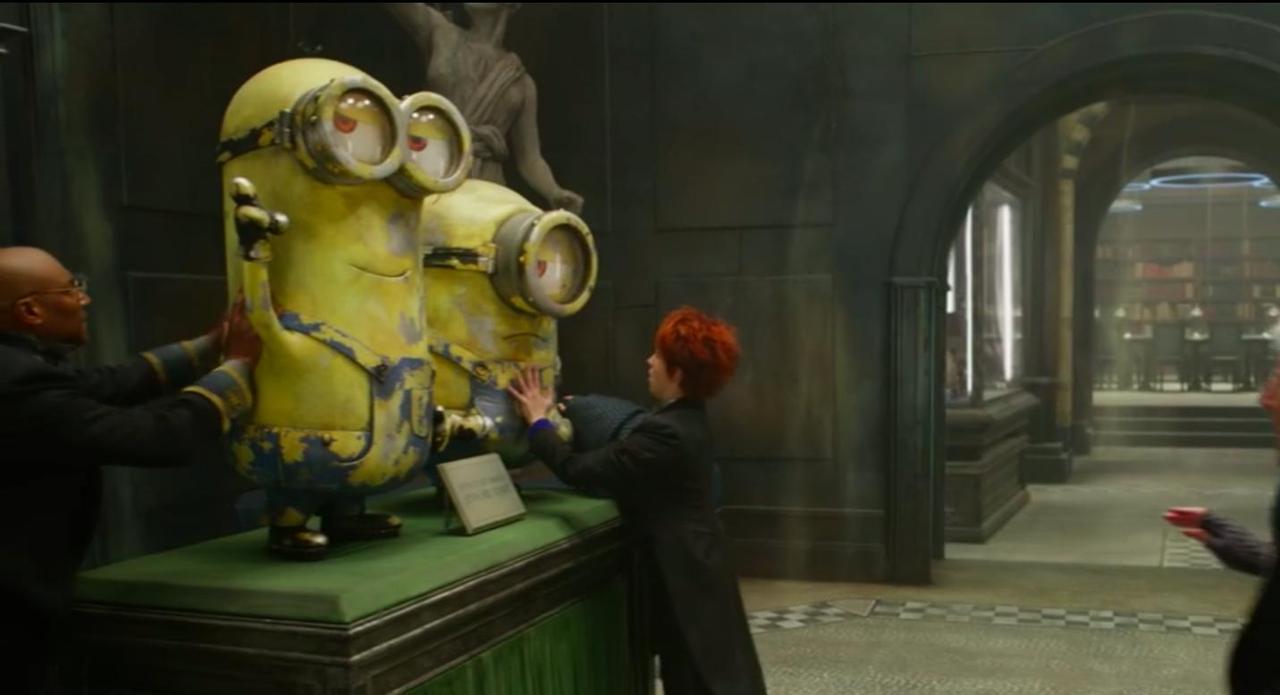
In the final scene of the 2018 film adaptation of Philip Reeves’ Mortal Engines, the two main characters embrace lovingly on an airship. They are floating over the now serene fallout of the hideously choreographed final battle scene, and as the music swells the camera zooms out as it orbits around them. This is what I assumed was happening, until I noticed that the background scenery was completely stationary and in fact what was happening was that the ship was spiralling aimlessly through the air with no one at the helm. Since the film is entirely bereft of convincing acting, three-dimensional characters and personality, what is left is a skeleton of significant ideas about society which is animated by a muscular system of narrative cliché and dressed in the skin of a computer graphics driven adventure film.
Produced by Peter Jackson, the film is the single biggest box office flop in history. It sees a cast of video game characters romp around a post-apocalyptic Europe. A thousand years have passed since some catastrophe, and now cities are giant tanks which roll around eating each other in an economic mode of production named “Municipal Darwinism”. The most interesting thing about this film is the premise of its moving cities; and the ageographical nature of these violent “predator cities” puts a funny spin on the brands of nationalism that exist in their populations. The city of London chases down and destroys smaller cities and towns—its prey—and as it does this the Londoners stand on deck and scream their football-hooligan admiration for their proud city. Once London is unmoored from the landmass that once supported it, this nationalism becomes a modular, plastic one: now finally free of its feudal and aristocratic baggage, London literally resembles the operation of capital, which economic geographer David Harvey describes as “value in motion”. The Darwinian confrontation of municipalities described here, when one gigantic rolling fortress literally swallows a smaller one, is anything but subtle. London’s giant maw—hundred of meters wide—is branded with the Union Flag.
In an early scene, museum staff hurry to save two giant statues of Minions as they threaten to topple over. “We almost lost our American deities!” Of course, it’s supposed to be funny that these future historians could misunderstand our (the West’s) culture to this extent. In the books, the piece of ancient pop culture iconography that goes into this joke is Mickey Mouse.
It seems somewhat more plausible that Mickey Mouse could be considered a deity of an American pantheon by a future civilisation, so using Mickey instead of some more contemporary particle of pop culture ages the book differently—and indeed the characters of the two versions of this joke will diverge more and more from each other as time passes. Writing in 2004, Reeve might have picked Tamagotchis as the subject of his little joke, which would have probably felt much less out of place in 2021 than this Minions reference will probably feel to a viewer in 2038, if anyone still remembers this film then.¹ Hugo Weaving’s atrociously acted villain, Thaddeus Valentine, is rogue historian. Is that a unique villain type? In practise it seems he’s something more akin to an archaeologist-maverick-swashbuckler, but he’s named in the text as the head historian of London’s Natural History Museum. What is it that is being said about history here? The Minion is immediately recognised by the viewers as an absurd image when translated forward in time beyond its window of cultural relevance. This is a film about history and historians, which means it constantly howls at its viewers something which is normally a more subtextual aspect of post apocalypse films: “I am not supposed to represent a plausible picture of the future, post disaster. I exist to show you what you think about yourselves, and about disaster, in the present.” This recent Jacobin article by Jim Poe on Mad Max advances the argument that “at their core, Miller’s films aren’t so much a prediction of the future as an indictment of our capitalist present and the ruthless individualism that maintains it.” I maintain that this is true—whether the author means it to be or not—of any post apocalyptic narrative made under a capitalist mode of production, which is of course practically all of them. What would it mean for a prediction of the future to not entail some reflection on the capitalism of the present? Capitalism is synonymous with the Anthropocene. If some prodigious writer manages to wriggle free of Capitalist Realism and develops an immunity to the psychological limitation that their material condition inflicts, I hope that she uses her insight to do more than write science fiction.

In On Analogy and Yasujiro Ozu, I made the point that language’s imprecision admits meaning other than that intended by the writer. They might be described as unwanted meanings, but they are only so if one's ambition in writing is especially pointed and driven by some external purpose: a coherent allegory or satire for instance requires some precision in its rhetorical focus if the writing is to serve as a tool for the elucidation of some idea the writer considers important. The writer’s consideration is important to the confrontation between attention and the surrounding unnoticed—the “hierarchy of meaning” is a hierarchy only within that framework of the writer’s ideological movements. Almost everything interesting there is to be said about Mortal Engines the film is something that it seems the filmmakers did not mean to say². What is said accidentally is more affecting than what was said on purpose, dissolving—or at least generating an alternative to—the hierarchy of meaning.
Mortal Engines includes among its various images one of London as a mobile devourer. In 2004, Britain had just invaded Iraq and felt invincible, standing behind the USA in its monstrous warpath of Imperial expansion as a second fiddle. In 2018, Britain was in the middle of an international embarrassment over Brexit. No longer a devourer, Britain was seen by the liberal consensus as a withered husk, destined for oblivion on the national stage without access to the Utopian single market. A pitiable relic, the Empire in its final stage of complete decline and collapse. London itself still devours plenty in its capacity as a financial hub—constantly draining capital away from the North and Midlands—but acknowledgement of this fact is seen as an unforgivable capitulation to the obscene rhetoric of the far right’s Vote Leave campaign. The maverick cabal of liars and cheats who ran that campaign now holds office, and is seen as fundamentally different to the more palatable “grown-ups in the room” who once ruled this mighty land, for some reason.
I don’t think about Minions very much since I don’t have any of my (thankfully few) conservative relatives added on Facebook. The Minion as a symbol has now become, in a grimly comic fashion, synonymous with Boomer Memes. These run the gamut from inane exclamations about needing coffee to wake up in the morning to viscerally horrifying far right propaganda: cutesy little yellow men in overalls shrug and trip over each other in a benign slapstick routine as disembodied text floating next to them reminds you that this fluffy haired old biddy is a eugenics fan. Reeves’ original Mickey God is more plausible—it’s what the futurologist would pick—but the Minion is a more powerful symbol in this context precisely because it’s entirely unbelievable. It reminds us that, in the words of Alex Edward of the Minion Death Cult Podcast: “The world is ending. Your uncle’s Facebook feed is responsible.”

So, what does Mortal Engines show us about what we think of disaster in the present? Thaddeus Valentine’s reckless pursuit of the very weapon that destroyed our civilisation looks like a parable about nuclear warfare. But then, he ends up actually firing this weapon multiple times in the finale of the film. It looks absolutely farcical. This terrifying weapon—apparently so deadly that it drove a war so destructive that the entirety of civilisation was destroyed in just sixty minutes—has to be used upwards of three times simply to destroy a quite large wall. This is no atom bomb. The plucky heroes finally manage to approach London by air, avoiding the guns by flying low, (apparently a giant rolling battleship that preys on small grounded prey is incapable of pointing its guns downward) and infiltrating the heavily fortified base of operations through the front door. With the current popular conception of the UK, this is the sort of Armageddon the world might expect us to enact. Drawn out, shambolic, inept. Disarmed by teenagers with a little bit of luck and a lot of friendship.
In 2005, a year after the first book in the Mortal Engines Quartet was completed, Destiny's Child embarked on their final tour, which was billed as such. See us now or regret it forever—the materialisation of a moment that would be impossible to archive, an event that would never be re-enacted, something that one needed to be ready for. The tour’s official name was "Destiny Fulfilled...and Lovin' It", because it was sponsored by McDonald's.

¹ If anyone reading this in 100 years knows what a Minion is, I'll eat my shoes. In what is perhaps the most hubristic thing I will ever say, I wager that it is more likely that at least one person in 100 years will actually read this and not know what a Minion is than it is that Minions are still culturally relevant by then. Of course, by far the most likely scenario is that both Minions and my own work will have been long forgotten by then.
² The books, particularly the later volumes, include some differently interesting material which might be worth some attention. I don’t remember much about the books after reading them more than a decade ago, but what I do remember is all good and it makes me think that Reeve knew what he was doing. This piece is too long already though, so if those books are worth writing about I will do it some other time.